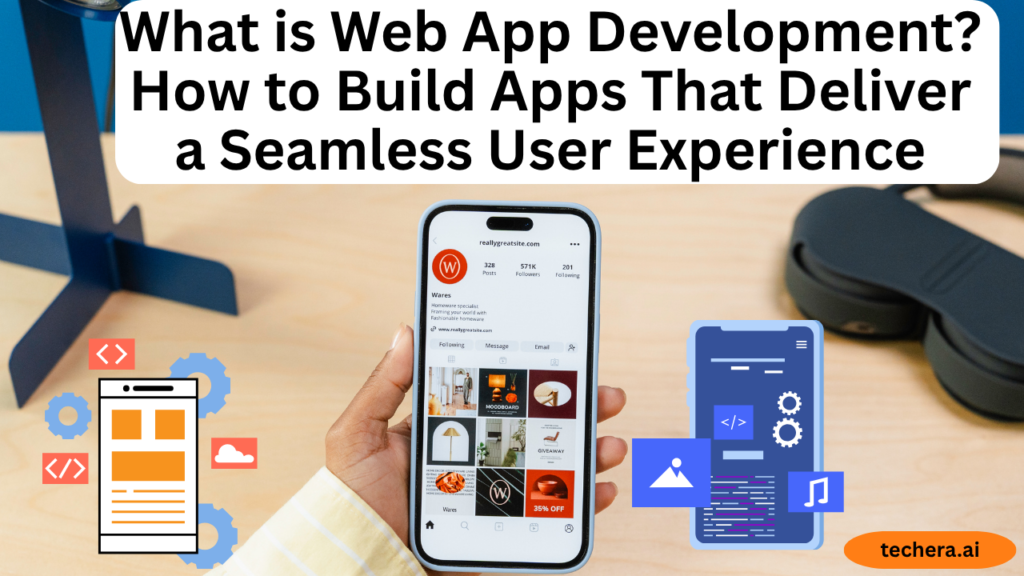
What is Web App Development? In this post, we break down the essentials of web app development and share practical strategies for building apps that offer a seamless user experience. Learn how design, performance, and usability come together to create successful digital products.
Introduction
What is a Web Application?
A web application is an interactive program that runs in a browser. What is Web App Development? Unlike static websites that only display content, web apps allow users to perform tasks—think Gmail, Trello, or Canva.
Difference Between Web Apps and Websites
Websites provide information. Web apps provide functionality. If you can interact with it beyond scrolling and reading, it’s probably a web app.
Why Businesses Choose Web Apps
They’re easy to update, platform-independent, cost-effective, and provide global reach. No downloads. Just access via a browser from any device.
The Importance of Seamless User Experience (UX)

What Makes an Experience ‘Seamless’?
It feels natural. Users don’t have to think—everything just works. No lag, no confusion, no roadblocks.
User Expectations in 2024
People expect lightning-fast, intuitive, responsive apps that “just know” what they need. That’s the bar.
Impact of UX on Engagement and Retention
Good UX builds trust and loyalty. Bad UX? Users bounce in seconds, and many never come back.
Core Components of Web App Development
Front-End Development
HTML5, CSS3, and JavaScript
These are the building blocks. JavaScript provides functionality, CSS adds style, while HTML provides structure.
Frameworks (React, Vue, Angular)
These tools help you build dynamic, modular, and scalable user interfaces.
Back-End Development
Languages (Node.js, Python, Ruby)
The back-end handles logic, database communication, and server interaction.
Databases and APIs
Databases store data; APIs connect services and provide real-time updates.
Full Stack and DevOps Integration
A full stack approach streamlines collaboration. DevOps ensures faster releases and consistent testing.
Key Principles for Creating Seamless UX
Fast Load Times
Speed matters. If your app takes more than 3 seconds to load, expect high bounce rates.
Intuitive Navigation
Users should always know where they are and how to get where they want to go—without asking.
Responsive Design
Your app should work flawlessly on all screen sizes—phones, tablets, desktops.
Accessibility for All Users
Make it usable for people with disabilities—keyboard navigation, screen reader support, color contrast.
Designing for the User
User-Centered Design
Put your users at the center. Every feature, layout, and message should solve their problems.
Building Intuitive UI
Keep it clean. Group similar elements. Use common UI patterns. Don’t reinvent the wheel.
Conducting UX Research
Surveys, interviews, heatmaps—understand how users behave, then build around that.
Performance Optimization Techniques
Lazy Loading and Code Splitting
Load only what’s needed, when it’s needed. Speeds up first interaction.
Minimizing HTTP Requests
Less is more. Combine files, use SVGs, and reduce redirects.
Leveraging Browser Caching
Store data locally for repeat visits. This slashes load times and server strain.
The Role of Progressive Web Apps (PWAs)
Offline Access and Speed
PWAs load even without a stable connection. Users get consistent experience anywhere, anytime.
App-Like Experience
Like native apps, they may be placed on home screens and provide push alerts.
Benefits for UX
Fast, responsive, engaging. PWAs deliver top-tier UX on a budget.
Testing for UX Consistency
A/B Testing
Test two versions of a page or feature to see which performs better.
Usability Testing
Watch users interact with your app. See where they struggle. Fix it.
Real User Monitoring (RUM)
Track real-time data on app performance, load times, and user behavior.
Security and Seamless Experience
Protecting User Data
Use secure authentication, encrypted databases, and regular security audits.
HTTPS and Secure Authentication
Always use SSL. Implement OAuth, JWT, or similar protocols for user logins.
Avoiding Disruptive Security Warnings
Make sure your certificates are valid and your app avoids triggering browser alerts.
Integrating Feedback Loops
In-App Feedback Systems
Let users report bugs or share ideas without leaving the app.
Analytics and User Behavior Tracking
Use tools like Google Analytics or Hotjar to see what’s working.
Iterative Improvements Based on Feedback
Small changes, tested often, lead to big improvements over time.
Real-World Examples of Great UX in Web Apps
Google Docs
Auto-save, real-time collaboration, simple UI—what’s not to love?
Trello
Drag-and-drop simplicity combined with powerful integrations.
Also Read : What is Web App Development? Key Trends to Watch in 2024
Airbnb
Clean interface, seamless booking experience, mobile responsiveness—all top-notch.
Common UX Mistakes to Avoid
Cluttered Interfaces
Don’t overload users with too much at once. Use whitespace and focus points.
Slow Loading Pages
Optimize images, compress files, and use CDNs.
Inconsistent Design Language
Stick to a theme. Fonts, colors, buttons—all should feel like part of one experience.
Best Practices for Web App Development in 2024
Mobile-First Approach
Design for the smallest screen first. Then scale up.
Modular Architecture
Break code into reusable components. It’s easier to maintain and test.
Continuous Integration/Deployment
Automate testing and releases to keep your app up-to-date and bug-free.
Future Trends in UX-Focused Web Development

AI-Personalized Experiences
AI will adapt content and layouts based on user behavior and preferences.
Voice-Driven Interfaces
As voice search grows, web apps will need to listen and respond smartly.
Emotionally Intelligent Design
Apps will start reading user sentiment and adapting tone and interface accordingly.
Conclusion
What is Web App Development? in 2024 is all about one thing—the user. You can have the best features, fastest tech stack, and sleekest codebase, but if the experience isn’t seamless, users will walk away. Whether you’re building a new SaaS platform or redesigning an existing tool, focus on speed, simplicity, accessibility, and above all—what your users truly need. Because at the end of the day, great UX isn’t an add-on—it’s the product.
Frequently Asked Question
Q. What’s the difference between UI and UX in web app development?
A. UI is what users see; UX is how they feel using it. Both are critical, but UX has a bigger impact on success.
Q. How do I know if my web app has good UX?
A. Track metrics like session duration, bounce rates, and user feedback. You’re on the right road if visitors continue to return and convert.
Q. Can PWAs replace native mobile apps?
A. For many use cases, yes. PWAs are cheaper, faster to build, and require no app store approval.
Q. How long is it to create a web application with excellent user experience?
A. Depending on complexity, MVPs usually take three to six months. UX testing adds time—but saves headaches later.
Q. Do I need a designer for UX or can developers handle it?
A. A dedicated UX/UI designer is ideal. Developers can implement, but designers create experiences that truly delight users.

